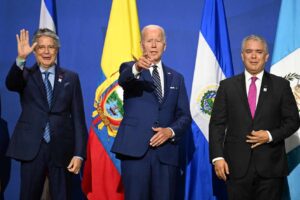
Ecuador’s President Guillermo Lasso (L), US Presiden Joe Biden (C) and Colombia’s President Ivan Duque (R) gesture during a migration declaration during the 9th Summit of the Americas in Los Angeles, California, June 10, 2022. (Photo by Jim WATSON / AFP
What does our website focus on?
Our project is rooted in the economic ties between the United States, foreign powers, and Latin American countries themselves. The United States has been a bilateral economic partner with Latin America for the last 50 years, with the creation of NAFTA (North American Free Trade Agreement), in 1994 by President Bill Clinton, denoting an important benchmark of trade globalization between Northern and Southern America.
9/11 marked a dramatic shift where economic and humanitarian aid, in addition to trade, became common provisions from the United States to Latin American countries. However, there is now more competition and pushback on America to provide aid to Latin American countries, as foreign powers get involved and Latin American countries are able to become more economically involved on their own. Despite this pushback, the United States still holds a major monopoly in security training practices throughout Latin America, which allows economic bureaucracies within the United States to generate revenue, which is then donated back as economic aid.
Even though the United States still has much influence within Latin America, many countries still stand out with whom the United States provides the most economic aid. The main receivers are Mexico, Brazil, Colombia, Cuba, and Venezuela.
How do we analyze economic aid across an array of Latin American countries?
Through our sources as well as knowledge gained through the lectures in U.S. & Latin American Relations, we examined the overarching themes within Latin America regarding economic aid. Collectively, we looked over ideas of how the United States was involved as well as world pole powers (China and Russia) within certain regions and how aid contributors behave according to their economic policy. Additionally, we examine how aid from disaster relief and COVID-19 relief (humanitarian aid) impacted Latin American countries. We also take into consideration the political climates within a country, and how certain political stances can impact aid from the United States, as well as foreign powers such as China and Russia. There are varying degrees of factors that all come together to impact how economic aid is analyzed in each country, which can be explored throughout our website.
Recent Comments